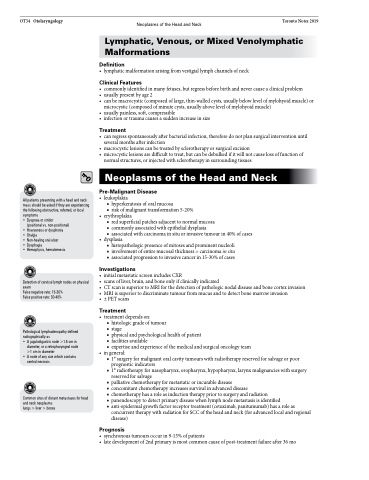Page 1020 - TNFlipTest
P. 1020
OT34 Otolaryngology
Neoplasms of the Head and Neck Toronto Notes 2019 Lymphatic, Venous, or Mixed Venolymphatic
Malformations
Definition
• lymphaticmalformationarisingfromvestigiallymphchannelsofneck
Clinical Features
• commonlyidentifiedinmanyfetuses,butregressbeforebirthandnevercauseaclinicalproblem
• usuallypresentbyage2
• canbemacrocystic(composedoflarge,thin-walledcysts,usuallybelowlevelofmylohyoidmuscle)or
microcystic (composed of minute cysts, usually above level of mylohyoid muscle) • usuallypainless,soft,compressible
• infectionortraumacausesasuddenincreaseinsize
Treatment
• canregressspontaneouslyafterbacterialinfection,thereforedonotplansurgicalinterventionuntil several months after infection
• macrocysticlesionscanbetreatedbysclerotherapyorsurgicalexcision
• microcysticlesionsaredifficulttotreat,butcanbedebulkedifitwillnotcauselossoffunctionof
normal structures, or injected with sclerotherapy in surrounding tissues
Neoplasms of the Head and Neck
Pre-Malignant Disease
• leukoplakia
■ hyperkeratosis of oral mucosa
■ risk of malignant transformation 5-20%
• erythroplakia
■ red superficial patches adjacent to normal mucosa
■ commonly associated with epithelial dysplasia
■ associated with carcinoma in situ or invasive tumour in 40% of cases
• dysplasia
■ histopathologic presence of mitoses and prominent nucleoli ■ involvement of entire mucosal thickness = carcinoma in situ ■ associated progression to invasive cancer in 15-30% of cases
Investigations
• initialmetastaticscreenincludesCXR
• scansofliver,brain,andboneonlyifclinicallyindicated
• CTscanissuperiortoMRIforthedetectionofpathologicnodaldiseaseandbonecortexinvasion • MRIissuperiortodiscriminatetumourfrommucusandtodetectbonemarrowinvasion
• ±PETscans
Treatment
• treatmentdependson:
■ histologic grade of tumour
■ stage
■ physical and psychological health of patient
■ facilities available
■ expertise and experience of the medical and surgical oncology team
• ingeneral:
■ 1° surgery for malignant oral cavity tumours with radiotherapy reserved for salvage or poor
prognostic indicators
■ 1° radiotherapy for nasopharynx, oropharynx, hypopharynx, larynx malignancies with surgery
reserved for salvage
■ palliative chemotherapy for metastatic or incurable disease
■ concomitant chemotherapy increases survival in advanced disease
■ chemotherapy has a role as induction therapy prior to surgery and radiation
■ panendoscopy to detect primary disease when lymph node metastasis is identified
■ anti-epidermal growth factor receptor treatment (cetuximab, panitumumab) has a role as
concurrent therapy with radiation for SCC of the head and neck (for advanced local and regional disease)
Prognosis
• synchronoustumoursoccurin9-15%ofpatients
• latedevelopmentof2ndprimaryismostcommoncauseofpost-treatmentfailureafter36mo
All patients presenting with a head and neck mass should be asked if they are experiencing the following obstructive, referred, or local symptoms
• Dyspnea or stridor (positional vs. non-positional)
• Hoarseness or dysphonia
• Otalgia
• Non-healing oral ulcer
• Dysphagia
• Hemoptysis, hematemesis
Detection of cervical lymph nodes on physical exam
False negative rate: 15-30%
False positive rate: 30-40%
Pathological lymphadenopathy defined radiographically as
• A jugulodigastric node >1.5 cm in
diameter, or a retropharyngeal node
>1 cm in diameter
• A node of any size which contains
central necrosis
Common sites of distant metastases for head and neck neoplasms
lungs > liver > bones


